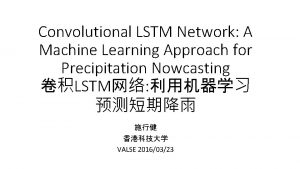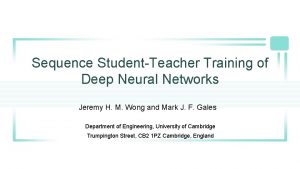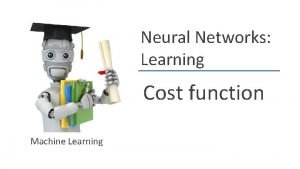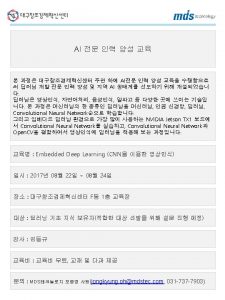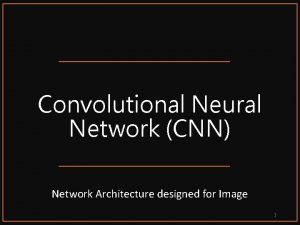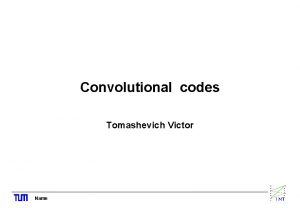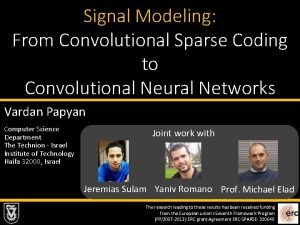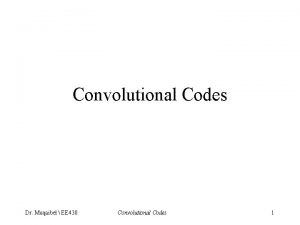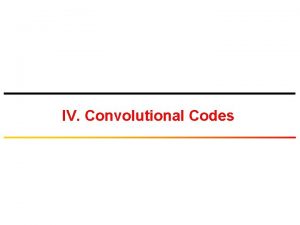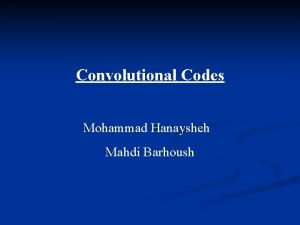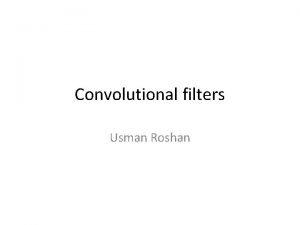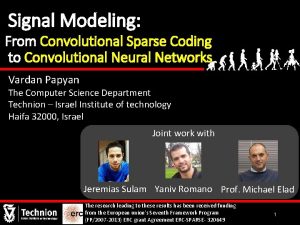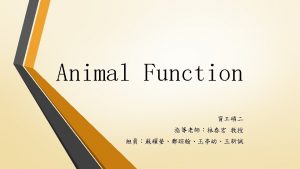Intelligent Integration of Enterprise Convolutional Neural Network Outline
















- Slides: 16

智慧化企業整合 Intelligent Integration of Enterprise Convolutional Neural Network 助教: 陳可馨

Outline • Why CNN for image • Convolutional Neural Network üConvolution Layer üPooling Layer-Max Pooling üFlatten • Demo • Class Assignment & Homework

Why CNN for image? • Some patterns are much smaller than the whole image • The same patterns appear in different regions. • Subsampling the pixels will not change the object

Convolutional Neural Network

The Whole CNN Can repeat many times

Why CNN for image? • Some patterns are much smaller than the whole image Convolution • The same patterns appear in different regions. • Subsampling the pixels will not change the object Max Pooling

Convolution Layer network parameters to be learned. What we see What computer see

Convolution Layer Kernels/filters: each filter detects a small pattern (for example: 3 x 3).

Convolution v. s. Fully connected 1 0 0 1 1 -1 -1 -1 0 1 0 -1 1 -1 0 0 1 1 0 0 -1 -1 1 0 0 0 1 0 1 0 convolution image 0 0 0 1 0 0 0 1 1 0 0 0 1 0 0 0 1 0 … Fullyconnected 1

1 -1 -1 -1 1 1: 1 Filter 1 2: 0 3: 0 4: 0 0 0 1 0 0 1 1 0 0 6 x 6 image Less parameters! 7: 0 8: 1 9: 0 10: 0 … 0 1 0 0 … 1 0 0 1 3 13: 0 14: 0 15: 1 16: 1 Only connect to 9 input, not fully connected … Shared weights

Pooling Layer-Max Pooling 1 0 0 1 0 0 0 1 0 1 1 0 0 0 1 1 0 0 6 x 6 image New image but smaller Conv Max Pooling 3 -1 0 3 1 0 1 3 2 x 2 image Each filter is a channel

Flatten 3 3 0 30 1 -1 0 1 3 1 Flatten 3 -1 1 0 3 Fully Connected Feedforward network

Demo

References • http: //speech. ee. ntu. edu. tw/~tlkagk/courses/ML_2016/ Lecture/CNN%20(v 2). pdf • https: //medium. com/jameslearningnote/%E 8%B 3%87 %E 6%96%99%E 5%88%86%E 6%9 E%90%E 6%A 9%9 F%E 5%99%A 8%E 5%AD%B 8%E 7%BF%9 2 -%E 7%AC%AC 5 -1%E 8%AC%9 B%E 5%8 D%B 7%E 7%A 9%8 D%E 7%A 5%9 E%E 7%B 6%9 3%E 7%B 6%B 2%E 7%B 5%A 1%E 4%BB%8 B%E 7%B 4% B 9 -convolutional-neural-network-4 f 8249 d 65 d 4 f

Class assignment • Please train a CNN with 3 Conv 2 D layers and 2 Maxpooling 2 D layers( try different activations, e. g. sigmoid, relu, etc. ). to predict the class of input images in Fashion Mnist dataset, and the testing accuracy should be at least 95%. • Turn in your work with the format of. ipynb , and please write some brief comments in your ipynb to illustrate your results. • File name: class 6_Your Chinese Name 15

Homework • Please use the Cifar-10 dataset and what we taught in TA class to train a CNN model ( you may design your own CNN model), and the testing accuracy should be at least 60%. • You are encouraged to implement different methods to train your model. (EX: dropout or different optimizers) • Turn in your work with the format of. ipynb , and please write some brief comments in your ipynb to illustrate your results. • File name: hw 6_Your Chinese Name 16
 Convolutional neural network ppt
Convolutional neural network ppt Alternatives to convolutional neural networks
Alternatives to convolutional neural networks Convolutional neural network
Convolutional neural network Visualizing and understanding convolutional networks
Visualizing and understanding convolutional networks Convolutional neural networks for visual recognition
Convolutional neural networks for visual recognition Leon gatys
Leon gatys Sparse convolutional neural networks
Sparse convolutional neural networks Xooutput
Xooutput Lmu cis
Lmu cis Convolutional neural networks
Convolutional neural networks Fc-lstm
Fc-lstm Risk intelligence map deloitte
Risk intelligence map deloitte Intelligent information network
Intelligent information network Neuroplasticity ib psychology
Neuroplasticity ib psychology Least mean square algorithm in neural network
Least mean square algorithm in neural network Student teacher deep learning
Student teacher deep learning Cost function deep learning
Cost function deep learning










